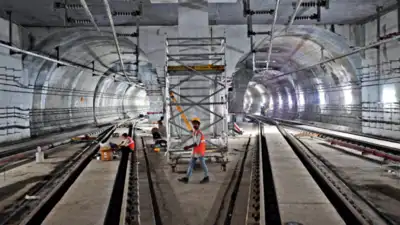ARTICLE AD BOX

Within a fortnight, Mumbai’s decades-long dream of a seamless underground transit system will come one step closer to reality. When the final leg of the AareyCuffe Parade Metro Line 3, stretching from Acharya Atre Chowk (Worli) to Cuffe Parade, opens this month, ridership on the underground corridor, which currently hovers around 60,000 passengers daily, is expected to treble to nearly 2 lakh.
At the same time, the city’s cumulative metro ridership across all lines is projected to cross the 10-lakh mark daily — a slow but definitive shift away from saturated local trains and chocked roads. Fare for the entire Metro 3 run will rise by just Rs 10 from the current Rs 60 for Aarey-Worli (phases 1 & 2).“It’s a game-changer,” said Shivraj Naik, a daily flyer from South Mumbai. “A one-hour taxi ride to the airport will now take just 35 minutes on metro at one-tenth the cost.”
From Mumbai Central to BKC,metro fares will be Rs 60, while taxis charge Rs 400. Officegoers are already hailing theshift. “Peak-hour traffic eats into our day. Metro 3 will save both time and money,” said Pooja Shetty, a marketing executive working in BKC.
As the first fully underground metro line nears completion, planners and commuters alike are pinning their hopes on what could be a generational transport shift, away from choked roads and overburdened local trains, and towards a faster, cleaner and more reliable alternative.
Metro 3 — also known as the Cuffe Parade-BKC-Aarey corridor — has opened in phases: the first stretch between Aarey and BKC was launched in Oct 2024, followed by an extension till Acharya Atre Chowk in March this year.
The initial response was 20,000 daily riders for Phase I and 60,000 after commissioning till Acharya Atre Chowk. But the ridership was disappointing as the limitations of partial connectivity became evident.
“This corridor is not competing with existing suburban rail routes. It’s designed for a new catchment that doesn’t have easy access to trains or even other metro lines at this point,” said Ashwini Bhide, managing director, Mumbai Metro Rail Corporation (MMRC). “Once we extend till Cuffe Parade and integrate with other metro lines over time, the ridership will not just double, it will continue to rise.”

Public policy analyst Paresh Rawal echoed this, saying, “At present Line 3 is a truncated route, andonce it goes up to Cuffe Parade, it will gain ridership.
This will be as heavily patronised as Line 1 (Ghatkopar-Andheri-Versova). I consider this a trunk route which will provide north-south connectivity.” The last phase is particularly important as it enters the heart of Mumbai, covering Nariman Point, Fort, Churchgate, CST, Charni Road, Kalbadevi, Grant Road and Worli.
These areas represent some of the city’s oldest and largest employment zones, where thousands of daily commuters still rely on slow-moving buses, black-and-yellow cabs, and app-based taxis — all stuck in the city’s never-ending traffic.
Rawal said, “The line will gain huge patronage from areas in south Mumbai’s business district, which will also offer interchange with the suburban system on Central Railway at CSMT and Western Railway at Churchgate.” The same journey that might take 15-20 minutes by metro often stretches to over an hour by road. This time saving is what we believe will convince more people to switch modes, said a senior MMRC official.The broader impact will be seen across Mumbai’s metro network. Line 1 already records over 5 lakh daily commuters, while the Dahisar-Andheri corridor via Lines 2A and 7 accounts for another 3 lakh. With Metro 3 expected to bring in 2 lakh more passengers post-commissioning, the city could eventually touch 13 lakh in the long run, with a designed full capacity of 17 lakh.But for now, Metro 3 remains in a low-demand phase, primarily due to the lack of seamless interchanges.
“The moment Line 2B connects at BKC, Line 6 at JVLR, and the airport extension of Line 7 becomes operational, you will see a completely different picture,” Bhide said, admitting that public perception has been shaped by incomplete access. “We saw asimilar pattern with Pune Metro, where usage was low until corridors linked up. Metro networks behave differently — the real ridership emerges when integration and last-mile solutions are in place.”
To that end, MMRC has approved stops for shared autos and is in talks with aggregators like Uber to provide feeder connectivity. However, uptake has been limited. “Operators are waiting for more passengers, and passengers are waiting for more connectivity. It’s a classic chicken-and-egg scenario,” Bhide said.
Rawal noted that this pattern of slow uptake is not unusual. “People take time to change their mode of transport,” he said.With the line nearing full operation, commuting between major points in Mumbai is set to become faster and more affordable. The fare from Cuffe Parade to Aarey (33.6 km) will be just Rs 70, compared to Rs 500 charged by kaali-peeli taxis for the same stretch. Similarly, trips from CSMT to the airport terminals (T1 & T2) will cost Rs 70 by Metro 3, slashing the average taxi fare of Rs 400. In the long term, MMRC expects transit-oriented development (TOD) around several stations to expand the corridor’s catchment.
“We’ve received multiple TOD proposals. Once these translate into commercial and residential growth along the line, the ridership base will grow naturally,” said R Ramana, director (planning & real estate development and non-fare box revenue, MMRC.Bhide said, “Once 30% of Mumbai’s planned metro network becomes functional, we’ll begin to see true behavioural shift. Metro 3 is the spine of that change, the southern stretch its most vital link.”



.png)
.png)
.png)
















 1 hour ago
3
1 hour ago
3









 English (US) ·
English (US) ·